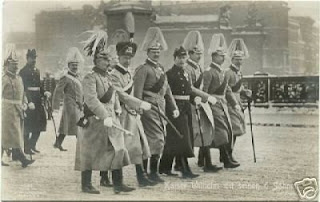Apparently there is a field of Real Photo Post Cards -- post cards that are effectively just a photograph (of the right size) with markings on the back to be used as a post card. I found a page by David Cycleback from September 2017 about "How to Date Real Photo Postcards". His area of interest is sports cards, but it's a more general discussion. In particular, he has a list of how to identify age ranges for some cards (which he attributes to the2buds).
This card follows from our World War I post card theme, but from the German point of view.
This postcard shows the last German Emperor Wilhelm II. (1859-1941) with his sons Crown Prince Wilhelm, Prince Eitel Friedrich, Prince Adalbert, Prince August Wilhelm, Prince Oscar and Prince Joachim of Prussia in parade uniform.
There are various similar photos on the Internet, but the view is slightly different. For example,
which seems to be the same event, but from a slightly different angle or time. The same with
which would seem to be the same as our photo, but cropped and labeled with the names of the people. There are pictures from the other side of the street.
Now this photo has two dates on it: "1584 Verlag von Gustav Liersch & Co, Berlin S. W." in the lower left and "Nach Original Aufnahme von Photograph O. Haeckel Berlin. 1907." ( which translates to "After original photograph by photographer O. Haeckel Berlin. 1907") in the right. Otto Haeckel (1872-1945) was a well-known photographer around this time. In retrospect, the 1584 might be a photo number, rather than a date.
But a similar photo, again different perspective, in Wikimedia dates it as 1 Jan 1913 or 27 Jan 1913 (the Kaiser's birthday).
The 27 Jan date gets a boost from another photo
Again this is (in the right corner this time) from "Verlag von Gustav Liersch & Co, Berlin S. W.", but numbered 4686, and in the right corner "A. Grohs. phot." (which would be Alfred Grohs (1880-1935)). The caption is "Der Kaiser nimmt die Gratulation der Ahlbecker Kinder zu seinem Geburtstag auf der Schlossbrucke entgegen" which translates to "The Kaiser accepts the congratulations of the Ahlbeck children on his birthday on the Castle Bridge." Ahlbeck is a region of Germany on the Baltic Sea, right next to Poland. The kids would be the the short people in the floppy hats near the left side of the photo.
But Getty Images has a copy that looks almost exactly like ours and labels it as 1 Jan 1912.
But look very closely at the two images -- the one just above from Getty images and the one at the very top of this post from our (scanned) post card. While they are almost identical -- look closely at the people behind the Kaiser. The Getty image has at least two soldiers mostly obscured by the Kaiser -- you can see their heads (and plumes) and one soldier's leg by the baton the Kaiser is carrying in his right hand.
Our post card has none!
This isn't just a different angle or slightly later -- the Kaiser is exactly the same, as are the others around him, and the background. (I changed the sepia colors of our post card to black and white to try to make the two pictures look more alike, so the missing people are more obvious.)
Apparently they were Photoshopped out! (A 100 years before Photoshop, so I guess they were airbrushed (?) out.) Why? Because they distracted your attention of the Kaiser? But if that's the goal, why wasn't the man in black erased too? Very curious!
A follow-up. A friend of mine took a Photoshop course and they went over how to reshape photos and lay the on top of one another to see how they differ. He took the Getty image, and laid our post card on top of it.
The way that everything lines up shows that this is the same photo. That is to say, the same negative was used. But when the negative was printed, to develop the picture, the two versions -- the post card and the Getty image -- were slightly rotated and then cropped differently. Plus there is the color difference -- black and white for Getty and a sepia for our post card.
If you then take the difference of the two photos, once they are lined up,
you can see what was removed from our post card print: The most prominent removal is the leg of one soldier that was behind the kaiser, from his waist down, showing thru between the kaiser's body and his arm. Above the kaiser's shoulder (on the photo's left, but the kaiser's right) we see the faces and plumes of the two soldiers that were removed. There is a third soldier's face and plume removed from the right of the kaiser -- between his head and the head of the man in black. It is not as easy to see that soldier.
Actually, I've found the easiest way to see the differences is to go back to the two cropped photos of just the kaiser walking (above) and click on one of them to see the larger photo. Then move forward and back between it and the adjacent (in the stream of photos). In my browser, I can do that with just a click of my mouse wheel, forward and back, forward and back. The two photos are not quite lined up in terms of crop and rotation, but close enough that your eyes will see the soldiers disappearing behind the kaiser, and then re-appearing, and then disappearing, as you toggle between the two photos.











No comments:
Post a Comment